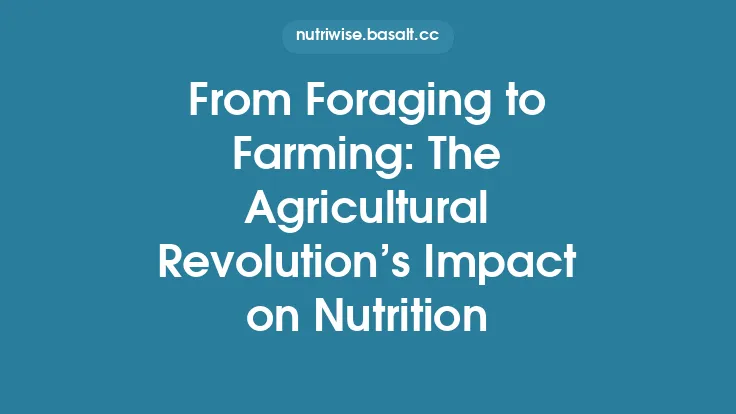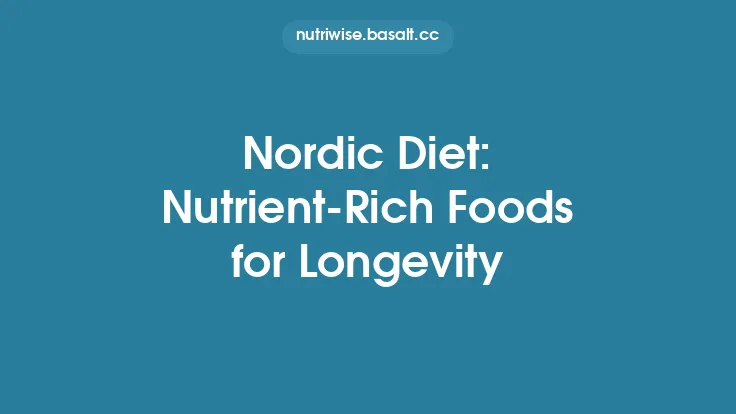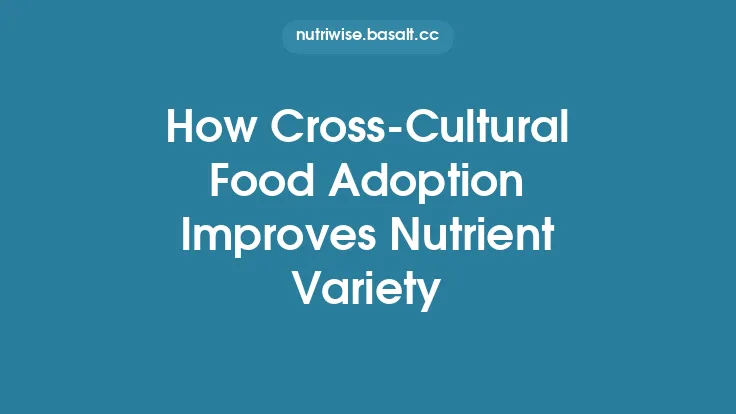The movement of peoples, ideas, and goods across continents has repeatedly reshaped what ends up on our plates. While the drama of spice caravans and the romance of silk‑road caravans often dominate popular narratives, a quieter but equally profound outcome of these exchanges is the emergence of foods that are exceptionally dense in essential nutrients. When a crop native to one region is introduced to another, it encounters new soils, climates, and culinary traditions. Over generations, farmers and consumers select for traits that enhance flavor, yield, and, inadvertently or deliberately, nutritional value. The result is a suite of foods that not only enrich culinary diversity but also serve as powerful tools against micronutrient deficiencies and chronic disease.
Historical Overview of Cross‑Cultural Food Introductions
The transfer of staple crops between the Old World and the New World after the 15th century—often termed the “Columbian Exchange”—represents the most consequential wave of food migration in human history. While the exchange of sugar, coffee, and tobacco is well documented, the nutritional implications of the accompanying staple crops have received comparatively less scholarly focus. When these crops entered new agro‑ecological zones, they underwent both natural adaptation and intentional breeding. For instance, the introduction of the potato to the high‑altitude Andes of South America prompted the selection of varieties with higher vitamin C content to counteract the risk of scurvy in cold climates. Similarly, the spread of maize (corn) into sub‑Saharan Africa spurred the development of “orange” maize varieties rich in provitamin A carotenoids, directly addressing endemic vitamin A deficiency.
These historical processes illustrate a pattern: cultural interaction creates a feedback loop in which nutritional gaps in a receiving population drive the selection of crop traits that improve the nutrient profile of the introduced food. Over centuries, this dynamic has produced a catalog of nutrient‑rich foods that are now integral to global diets.
Case Studies of Nutrient‑Rich Foods Born from Cultural Interaction
Tomatoes (Solanum lycopersicum)
Origin & Transfer
Native to the Andean region, tomatoes were domesticated in Mesoamerica before being carried to Europe by Spanish explorers in the early 1500s.
Nutrient Profile
Modern cultivated tomatoes are a leading source of lycopene, a carotenoid with potent antioxidant activity. They also provide vitamin C, potassium, and folate. The lycopene content varies dramatically among cultivars; heirloom varieties selected in Mediterranean climates often contain up to 30 mg lycopene per 100 g, far exceeding early European introductions.
Evolutionary Enhancement
European growers, seeking richer color and longer shelf life, inadvertently selected for higher lycopene concentrations. Subsequent breeding programs in the 20th century deliberately amplified this trait, resulting in “high‑lycopene” cultivars now marketed for their health benefits.
Potatoes (Solanum tuberosum)
Origin & Transfer
Domesticated in the Andean highlands, potatoes reached Europe via the Spanish conquest of the Americas. By the 18th century, they were a staple across the continent.
Nutrient Profile
Potatoes are a dense source of complex carbohydrates, vitamin C, potassium, and vitamin B6. Certain varieties, such as the “Purple Majesty,” contain anthocyanins—flavonoid pigments with antioxidant properties.
Adaptation to New Environments
In the cooler, less sunny climates of northern Europe, farmers selected for tubers with higher vitamin C to mitigate the risk of scurvy during long winters. This selection pressure contributed to the modern potato’s relatively high vitamin C content (≈20 mg per 100 g), especially when compared to other temperate root crops.
Maize (Zea mays)
Origin & Transfer
First domesticated in central Mexico, maize spread throughout the Americas before its introduction to Africa, Asia, and Europe after 1492.
Nutrient Profile
While white maize is primarily a source of carbohydrates, biofortified “orange” maize varieties contain elevated levels of β‑carotene (provitamin A). In addition, certain landraces are rich in lysine and tryptophan, essential amino acids that are limited in many cereals.
Targeted Breeding
The “orange” maize movement began in the 1990s when agricultural scientists in the United States and Africa deliberately crossed high‑β‑carotene lines with locally adapted varieties. The resulting hybrids deliver up to 15 mg of provitamin A per 100 g, a level sufficient to meet a substantial portion of the daily requirement for children in vitamin‑A‑deficient regions.
Chili Peppers (Capsicum spp.)
Origin & Transfer
Originating in the tropical Americas, chili peppers were disseminated worldwide by Portuguese and Spanish traders, reaching Asia by the early 16th century.
Nutrient Profile
Chili peppers are exceptionally rich in vitamin C (up to 140 mg per 100 g) and contain capsaicinoids, compounds that have been linked to metabolic regulation and pain modulation. They also provide vitamin A (as β‑carotene) and several B‑vitamins.
Selection for Heat and Nutrients
In many Asian cuisines, the demand for pungency drove the selection of hotter cultivars, which coincidentally possess higher capsaicinoid concentrations. Modern breeding programs have leveraged this relationship to develop “super‑hot” varieties that also retain high vitamin C levels, offering a dual benefit of flavor intensity and micronutrient density.
Soybeans (Glycine max)
Origin & Transfer
Domesticated in East Asia, soybeans were introduced to the Americas by European colonists in the 18th century and later re‑imported to Asia in the 20th century as a high‑protein crop.
Nutrient Profile
Soybeans are a complete protein source, containing all essential amino acids. They also supply isoflavones (phytoestrogens), vitamin K, folate, and minerals such as iron and calcium. Fermented soy products (e.g., tempeh, miso) further enhance bioavailability of these nutrients.
Cross‑Cultural Adaptation
When soybeans entered the American Midwest, breeders selected for varieties tolerant of cooler climates and shorter growing seasons. This led to the development of “early‑maturing” lines that retain high protein content (≈40 % of dry weight) while also accumulating greater levels of iron and zinc compared with their tropical ancestors.
Nutritional Science Behind the Benefits
Micronutrient Density and Bioavailability
The nutrient richness of these culturally transferred foods is not merely a function of their raw composition; it also reflects enhanced bioavailability. For example, the presence of lycopene in tomatoes is markedly increased when the fruit is cooked with a modest amount of fat, a culinary practice that became common in Mediterranean cuisines. Similarly, the fermentation of soybeans reduces antinutritional factors such as phytic acid, thereby improving mineral absorption.
Phytochemical Synergy
Many of the highlighted foods contain complex mixtures of phytochemicals that act synergistically. The combination of vitamin C and carotenoids in chili peppers, for instance, stabilizes the latter against oxidative degradation, ensuring that the body can effectively convert β‑carotene to retinol (vitamin A). In potatoes, the co‑presence of potassium and vitamin C supports electrolyte balance and antioxidant defenses simultaneously.
Impact on Glycemic Control
Starch‑rich crops like maize and potatoes have historically been viewed as high‑glycemic foods. However, specific landraces selected in response to local dietary needs exhibit altered starch structures—higher amylose content and increased resistant starch—that moderate post‑prandial glucose spikes. The “purple” potato varieties, for example, contain up to 15 % resistant starch, contributing to improved insulin sensitivity.
Influence on Public Health and Dietary Patterns
Mitigating Micronutrient Deficiencies
The introduction of vitamin‑rich crops into regions with historically limited dietary diversity has had measurable public‑health outcomes. In sub‑Saharan Africa, the adoption of orange maize has been linked to a 30 % reduction in the prevalence of night‑blindness among children under five. Similarly, the widespread cultivation of biofortified sweet potatoes (rich in β‑carotene) in East Africa has contributed to a decline in clinical vitamin A deficiency.
Diversifying Protein Sources
Soybean integration into non‑Asian diets has expanded the pool of plant‑based protein, offering an alternative to animal‑derived sources. This diversification is especially relevant in populations where livestock production is constrained by climate or economic factors. The high lysine content of soy complements the amino acid profile of cereals, creating more balanced plant‑based meals.
Supporting Sustainable Nutrition
While the article’s focus is not on sustainability per se, it is worth noting that many of these nutrient‑rich foods are well‑suited to low‑input agricultural systems. Maize varieties adapted to marginal soils, potatoes tolerant of cooler climates, and soybeans capable of nitrogen fixation collectively enable higher nutrient yields per unit of land, indirectly supporting food security.
Contemporary Research and Future Directions
Genomic-Assisted Breeding
Advances in genome sequencing have accelerated the identification of alleles responsible for nutrient accumulation. In tomatoes, the Solyc07g056570 gene has been linked to lycopene biosynthesis; CRISPR‑mediated editing of this locus is already producing “ultra‑red” varieties with lycopene concentrations exceeding 40 mg per 100 g. Similar genomic tools are being applied to potatoes to enhance vitamin C pathways while maintaining tuber yield.
Metabolomic Profiling
High‑throughput metabolomics now allows researchers to map the full spectrum of phytochemicals in traditional landraces. Studies on Andean potatoes have uncovered previously unknown flavonoids with anti‑inflammatory properties, suggesting that the nutritional value of these crops may be even broader than currently recognized.
Climate‑Resilient Nutrient Retention
As climate change alters growing conditions, there is a growing emphasis on breeding crops that retain their nutrient density under stress. Drought‑tolerant maize lines are being evaluated for their ability to maintain β‑carotene levels despite reduced water availability. Early results indicate that certain stress‑responsive transcription factors also upregulate carotenoid biosynthesis, offering a dual benefit.
Community‑Driven Seed Systems
In many regions, farmer‑led seed exchanges preserve the genetic diversity that underpins nutrient richness. Participatory breeding programs in the Andes and the Sahel have documented how local knowledge guides the selection of nutrient‑dense varieties, ensuring that improvements are culturally appropriate and agronomically viable.
Concluding Reflections
The story of nutrient‑rich foods born from cultural interactions is a testament to humanity’s capacity to turn exchange into enrichment. From the lycopene‑laden tomato that traveled from the highlands of Peru to the kitchens of Italy, to the orange maize that now brightens African fields, each crop carries a narrative of adaptation, selection, and health impact. By understanding the historical pathways that shaped these foods, and by leveraging modern scientific tools to further enhance their nutritional profiles, we can continue to build diets that are both diverse and health‑promoting. The legacy of cross‑cultural food exchange thus extends far beyond flavor—it is a cornerstone of global nutrition and a vital resource for addressing the dietary challenges of the 21st century.





